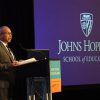With increased urgency following years of devastating school shootings, the attention of educators is now intently focused on ensuring students’ safety and health. The threats to students today are unprecedented in American history. Gun violence is only the most concerning of many complex issues that include everything from mental health, suicide, bullying, and other forms of trauma, that land atop long-standing concerns about nutrition, emotional well-being, and physical health.
Too often, America’s children are afraid to go to school and educators are short of practical ideas of what to do. Into that void steps the Center for Safe and Healthy Schools, an effort led by the Johns Hopkins School of Education. The center was introduced officially at the Annual National Seminar of the Education Writers Association hosted by Johns Hopkins in Baltimore in early May.
“Fear cannot be the basis for effective education policy or practice,” said Dean Christopher Morphew of the Johns Hopkins School of Education in his welcoming remarks at the conference, in which he introduced the center. “We need to do more to ensure that school leaders have the training and resources to create and maintain safe and healthy schools.”
Many universities are engaged in similar pursuits, but Johns Hopkins is the first institution of higher education to form a single cross-disciplinary center dedicated singularly to addressing such issues in total. The center declares student safety and health as a leading public health priority for American schools.
The Center for Safe and Healthy Schools is an interdisciplinary effort drawing upon experts from across the university, all coordinated through the School of Education. The center aims to leverage Johns Hopkins’ respected multidisciplinary research community to develop and inform a national dialogue and inspire action on the issue of school safety.
Associates in the center include more than 25 Hopkins faculty members drawn from the schools of Education, Public Health, and Arts and Sciences, and even taps security technology experts from the Applied Physics Lab. Likewise, it will look to engage community leaders from law enforcement, public health, medicine, engineering, business, and others in the effort.
Ultimately, the center will identify evidence-based, fundamental crisis approaches that will truly help education professionals foster safer learning environments. Its output will include research, but also practical tools, resources, and best-practice guidelines.
The center works along three research trajectories: student mental, physical, social, and emotional well-being; community engagement; and school security partnerships and technologies.
In his remarks, Morphew emphasized the marriage of research and practice designed to deliver practical, comprehensive, “evidence-based” solutions that schools can implement immediately to help ensure that students can learn in a safe and healthy environment. He charged the journalists in attendance with responsibility, stating that their role is critical to successful outcomes. The media must engage in the dialogue, not just cover the topic, and help spread the word of the mission of school safety, he said.
“This is a definitive, 21st-century education issue,” Morphew said, promising that Hopkins would embed safety and health programming into its counseling, teacher preparation, special education, and administration tracks preparing the newest generation of American educators.
The center announcement provided a bold kickoff to the Education Writers Association conference, the biggest annual convention for those who cover the field in the media. More than 600 journalists and communicators attended this year’s conference, the 72nd time the association has convened.
The program included an array of topics of national interest. This year’s conference featured a specific focus on the success, safety, and well-being of students. U.S. Secretary of Education Betsy DeVos was keynote speaker and sat for Erica Green, an education reporter for The New York Times.
Nine Johns Hopkins researchers, authors, and alumni were invited to speak in various panel discussions. Among those with ties to the School of Education were David Steiner, executive director of the Institute for Education Policy, who was on hand to help journalists understand how to cover what gets taught in America’s classrooms. Jonathan Plucker, the Julian C. Stanley Professor of Talent Development in the School of Education, contributed to a deep dive on racial disparities in access to gifted education. Katherine Bissett of the Rales Center discussed how schools are now becoming healthcare providers offering medical, dental, and vision care to students. And School of Education alumna Rhonda Richetta sat on a panel debating school discipline reform.

